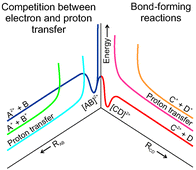Bimolecular reactions of molecular dications: reactivity paradigms and bond-forming processes†
Abstract
The bimolecular reactivity of molecular dications in the gas phase is reviewed from an experimental point of view. Recent research has demonstrated that in addition to the ubiquitous occurrence of electron transfer in the reactions of gaseous dications with neutral molecules, bond-forming reactions play a much larger role than anticipated before. Thus, quite a number of hydrogen-containing dications show proton transfer to neutral reagents as an abundant or even as the major pathway, and also the nature of the neutral reagent itself is decisive for the amount of proton transfer which takes place. Further, several hydrocarbon dications CmHn2+ of medium size (m = 6–14, n = 6–10) undergo bond-forming reactions with unsaturated hydrocarbons such as acetylene or benzene, thereby offering new routes for the formation of larger aromatic compounds under extreme conditions such as interstellar environments. Likewise, recent results on the bimolecular reactivity of multiply charged metal ions have revealed the occurrence of a number of new bond-forming reactions which open promising prospects for further research.


 Please wait while we load your content...
Please wait while we load your content...